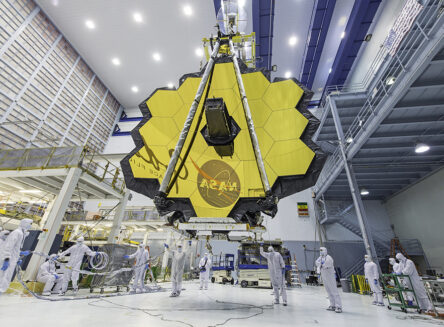
The Sky Is Never the Limit
The stars won't come out until November at the new performing arts center at Flathead Valley Community College, but attendees of the college's STEM Colloquium earlier this month got a look at stars of a different kind.
Compared with the Hubble, which launched in 1990, the James Webb Space Telescope takes things up a notch. The first "deep field" high-resolution imagery from the telescope, anticipated for more than 20 years, emerged this July.
It set the astronomy world on fire.
Jim Boger, FVCC physics professor, launched the colloquium topic, explaining that scientists had "pointed the telescope to the blackest patch of space, a patch of sky the size of a grain of sand if held at arm's length." The finding: "There were thousands of galaxies in that patch," he said.
As interesting as what the James Webb can do is how it does it. The mirror inside the telescope spans more than 6 meters, made up of 18 hexagonal segments, and its designers aimed for big "but not so big it doesn't fit in the rocket," Boger said. To solve that problem, he said the mirror "had to be folded up origami-fashion."
As a bookbinder and sometime papermaker I perked up at the origami reference and ecology professor Christina Relyea's earthbound part of the program. The hexagon shape is no accident — for telescope inventors or nature itself.
"Nature loves a tube," Relyea said. "Nature tends to order itself." She held up a fistful of straws packed together, which automatically squeezed into soft hexagonal shapes, to illustrate how hexagons fill a plane and minimize surface tension.
She pointed to honeycomb, tortoise shells, snake scales and snowflakes as proof of her point, concluding, "The James Webb copied nature."
She also threw in some humor, pointing out that the James Webb takes clear pictures of galaxies some billions of light-years away, but our standard security camera can't capture a sharp image of a ne'er-do-well from 10 feet. Let's get NASA on that!
I can hardly pick out anything more than the Big Dipper in the night sky. The weekend after the colloquium, I spent a few days with my sisters-in-law in Glacier National Park, which, together with neighboring Waterton Lakes National Park, was designated the first cross-border International Dark Sky Park.
We spent most of our time hiking, paddleboarding, on-road adventuring, kayaking and skipping rocks off the mirror surface of Lake McDonald. We also attended a talk at the amphitheater near Apgar.
Ranger Joseph Carlson gave an overview of thousands of years of Glacier history, from the hunting of megafauna in the Ice Age to industrial forces and discoveries that shape the landscape. He ended with an urging to get to know the new and different, to “read ‘stories’ around you — these literally tiny stories accumulate in a library of experience and understanding.”
After the presentation, like every night we spent in Glacier, we gathered to watch the sun sink and the stars pop out of the blackness.
Way above us, the James Webb Space Telescope orbited as we embraced our tiny slice of time and place.